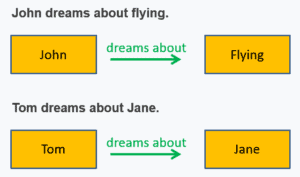A simple example – seems like magic, but it’s science.
Semantic graphs are able to store information in a rich, contextually and conceptually construct – complex data that represents the real world. This construct is commonly called a ‘triple’, has three key parts to store information with concept and context and does it in the most granular and atomic form. Triples are simply basic statements about information. A simple example:
1. John dreams about Jane
There are three parts of this triple:

With just these three parts that define the simplest of relationships, we can then construct the context of more complex relationships of information and capture the conceptual meaning within that data.
We can also use this construct to understand relationships that are *not* explicitly defined – information that is inferred from knowing many of these simple relationships stored as triples. Let’s add just two more (triple) statements:

From just these three simple statements AllegroGraph can now infer additional information and answer some simple but conceptually interesting questions like:
Q: Does anyone dream?
A: Tom and John
Q: What do people dream about ?
A: Flying and Jane
Q: Do Tom and John have anything in common ?
A: They like flying, they like Jane
Of course AllegroGraph is highly optimized to process information like the example, and to process real world complex data rapidly and at big data scale.

